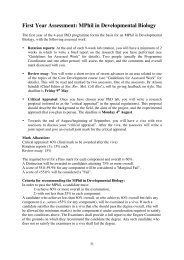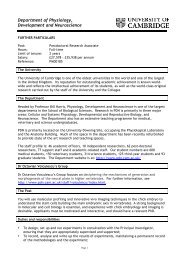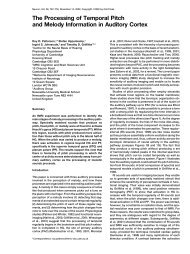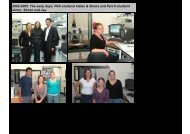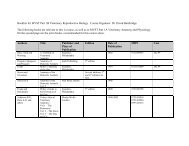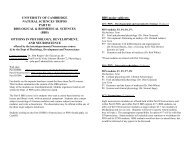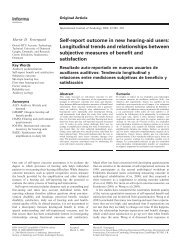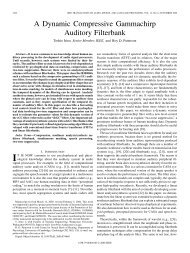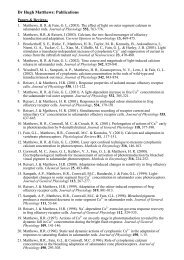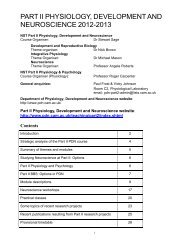FRIDAY MORNING, 20 MAY 2005 REGENCY E, 8:30 A.M. TO 12:00 ...
FRIDAY MORNING, 20 MAY 2005 REGENCY E, 8:30 A.M. TO 12:00 ...
FRIDAY MORNING, 20 MAY 2005 REGENCY E, 8:30 A.M. TO 12:00 ...
You also want an ePaper? Increase the reach of your titles
YUMPU automatically turns print PDFs into web optimized ePapers that Google loves.
<strong>FRIDAY</strong> <strong>MORNING</strong>, <strong>20</strong> <strong>MAY</strong> <strong>20</strong>05<br />
GEORGIA B, 8:<strong>30</strong> <strong>TO</strong> 11:45 A.M.<br />
Session 5aUW<br />
Underwater Acoustics: Scattering and Reverberation<br />
Purnima Ratilal, Chair<br />
Northeastern Univ., Electrical and Computer Engineering, 409 Dana Research Ctr., Boston, MA 02115-5<strong>00</strong>0<br />
Contributed Papers<br />
8:<strong>30</strong><br />
5aUW1. Identification of strong scatterer locations on the Malta<br />
plateau. Mark K. Prior NA<strong>TO</strong> Undersea Res. Ctr., Viale San<br />
Bartolomeo 4<strong>00</strong>, 19138, La Spezia, Italy, prior@saclantc.nato.int<br />
Reverberation data gathered in the Malta Plateau region of the Mediterranean<br />
Sea using a Low-Frequency Active Sonar LFAS and a cardioid<br />
receiver array are presented. A processing strategy involving normalization,<br />
geo-referencing and averaging over pings is described and is shown<br />
to highlight the locations of strong scatterers and to provide a first-order<br />
estimate of their strength. A second process of calculating the ratio of local<br />
standard deviation and mean values is shown to reveal scatterer locations<br />
and to provide an indication of whether the probability density function of<br />
the reverberation is well-described by the Rayleigh distribution. The characteristics<br />
of the observed scatterers are revealed by comparison with independent<br />
sidescan, echo sounder and boomer data. Areas of high reverberation<br />
are identified as being associated with wrecks, oil production<br />
platforms, rock outcrops and variations in local sediment properties.<br />
8:45<br />
5aUW2. Range-dependent 3D scattering and reverberation in the<br />
continental shelf environment from biology, geology and<br />
oceanography. Purnima Ratilal Northeastern Univ., 409 Dana Res.<br />
Ctr., Boston, MA 02115, Sunwoong Lee, Yisan Lai, Tianrun Chen,<br />
Deanelle Symonds MIT, Cambridge, MA 02139, Ninos Donabed<br />
Northeastern Univ., Boston, MA 02115, and Nicholas Makris MIT,<br />
Cambridge, MA 02139<br />
Several unified scattering and reverberation models were developed in<br />
support of the ONR Acoustic Clutter Program. They include a rangedependent<br />
model based on the parabolic equation that can be used to<br />
efficiently model scattering from a random spatial distribution of random<br />
targets that obey the sonar equation in the waveguide and a similar but<br />
range-independent waveguide model based on normal modes for scattering<br />
from extended objects. Both these models are bistatic and fully 3D,<br />
and the latter model also accounts for modal coupling between propagation<br />
and scattering caused by extended objects in the waveguide. These<br />
models are applied to examine both coherent and diffuse scattering measured<br />
after beamforming and match-filtering on an array from schools of<br />
fish, plankton, volume inhomogeneities in the sea bottom, roughness on<br />
the seafloor, extended seafloor and sub-bottom features such as river channels<br />
and reflective strata, and internal and surface waves. We provide a<br />
review of the dominant sources of clutter as well as background reverberation<br />
for long range active sonar based on comparison of model predictions<br />
with measured data from the Acoustic Clutter Experiments of <strong>20</strong>01 and<br />
<strong>20</strong>03.<br />
9:<strong>00</strong><br />
5aUW3. Dominant source of background reverberation during the<br />
Acoustic Clutter <strong>20</strong>03 experiment. Ninos Donabed, Purnima Ratilal<br />
Northeastern Univ., 409 Dana Res. Ctr., Boston, MA 02115, and<br />
Nicholas Makris MIT, Cambridge, MA 02139<br />
Reverberation data from the Acoustic Clutter <strong>20</strong>03 experiment on the<br />
New Jersey Continental shelf are analyzed to provide estimates of the<br />
background scattering strength over wide areas of the environment as a<br />
function of time. We corrected the acoustic data in the 390–440 Hz range<br />
for two-way transmission loss modeled using the range-dependent parabolic<br />
equation, the spatially varying beampattern of the receiving array,<br />
and source level to obtain estimates of the scattering strength per unit area<br />
of the environment. Data from regions of space devoid of strong clutter<br />
were statistically analyzed to provide a temporal and spatial characterization<br />
of the background scattering strength. They were then compared to<br />
scattering strength levels deduced from modeling from a variety of scatterers<br />
including schools of fish, the sea bottom, internal waves and surface<br />
waves. Analysis indicates that the dominant sources of background reverberation<br />
can be either low density fish schools or the sea bottom.<br />
9:15<br />
5aUW4. Higher moment estimation for shallow water reverberation.<br />
Kevin LePage Naval Res. Lab., Code 7144, 4555 Overlook Ave. SW,<br />
Washington, DC <strong>20</strong>375<br />
Shallow water reverberation is characterized by clutter which causes<br />
false alarms in sonar systems. In previous work we have estimated the<br />
non-Rayleighness of shallow water reverberation time series predictions<br />
obtained by the R-SNAP model. Here we extend the R-SNAP model to the<br />
closed form estimation of the second moment of reverberation intensity,<br />
allowing the estimation of pdf fits for the two parameter K distribution as<br />
a function of system and channel characteristics and time after shot. This<br />
work is intended to theoretically guide the selection of clutter-robust system<br />
characteristics. Work supported by ONR.<br />
9:<strong>30</strong><br />
5aUW5. Statistical characterization of sonar-like clutter observed on<br />
the STRATAFORM during the <strong>20</strong>03 Acoustic Clutter Experiment in<br />
the 4<strong>00</strong>–15<strong>00</strong> Hz region. John Preston and Douglas Abraham Appl.<br />
Res. Lab., The Penn State Univ., State College, PA 16804<br />
In <strong>20</strong>03 ONR sponsored the Acoustic Clutter Experiment to study<br />
shallow water scattering and clutter in the STRATAFORM area off New<br />
Jersey. Sources were bistatic coherent pulses from a vertical array. The<br />
receiver was the Five Octave Research Array used horizontally. The<br />
STRATAFORM is known to have benign surface morphology but contains<br />
many buried river channels and other sub-surface horizons. MIT researchers<br />
have shown fish to be a primary source of the observed clutter and<br />
reverberation. The K-distribution’s shape and scale parameters have been<br />
shown to be useful in describing non-Rayleigh behavior. Statistical characterization<br />
is presented as a function of location. The ‘‘bandwidth’’ effect<br />
is shown where the shape parameter first decreases inversely proportional<br />
to bandwidth but then increases in a trend back toward the Rayleigh distribution<br />
at higher bandwidths. The shape parameter estimates are well fit<br />
by an elongated patch model of Abraham and Lyons. Differences between<br />
the <strong>20</strong>03 and <strong>20</strong>01 data taken in the same area are discussed. It is believed<br />
that the sound speed profiles in <strong>20</strong>03 lead to more bottom interaction than<br />
in <strong>20</strong>01 producing a larger time spread in the multipaths leading to observed<br />
differences. Work supported by ONR Code 32, Grant N<strong>00</strong>014-05-<br />
1-0156.<br />
5a FRI. AM<br />
2611 J. Acoust. Soc. Am., Vol. 117, No. 4, Pt. 2, April <strong>20</strong>05 149th Meeting: Acoustical Society of America 2611



